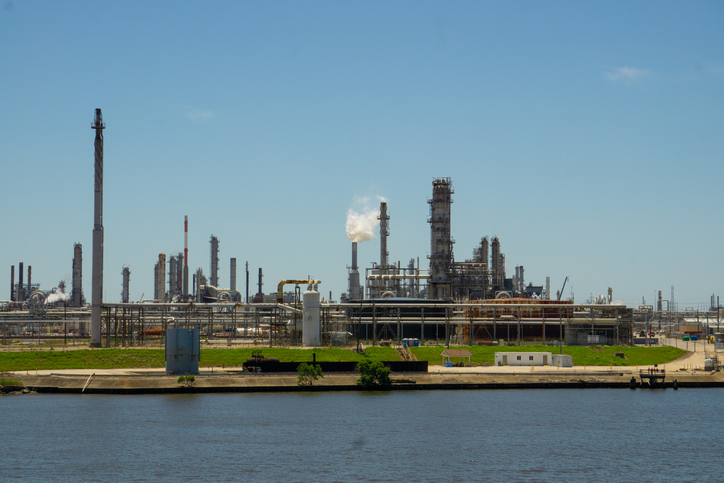
More than 1,000 communities across the United States are significant hotspots for cancer-causing pollution. According to a new analysis from ProPublica, the Houston Metro Region ranks prominently among them.
The Worst Cancer Polluting Plants in Houston
Using a modeling tool created by the U.S. Environmental Protection Agency (EPA), ProPublica mapped out how carcinogen-tainted pollutants spread from the country’s many chemical plants and refineries. The hardest-hit communities are primarily located in southern states with weak environmental regulations. One such state- Texas – is home to a quarter of the top 20 cancer pollution hotspots identified in the report, including the Houston Metro Region, which ranks as the eighth-worst in the nation.
In fact, ProPublica estimated that people living in Houston’s highest-risk areas have a 1 in 150 risk of developing cancer – more than 68-times higher than the acceptable risk level established by the EPA. The group also identified the Metro Region’s worst cancer-causing polluters, including:
- Huntsman Petrochemical LLC: This facility alone is estimated to increase the excess cancer risk for people living within five milesof the plant by an average of 1 in 13,000. Pollutants released include Ethylene oxide, Acrylonitrile, Propylene oxide, and two additional carcinogens.
- Celanese LTD Clear Lake Plant: This plant is also is estimated to increase the excess cancer risk for people living within five miles by an average of 1 in 13,000. Pollutants include Ethylene oxide, Methyl iodide, Acetaldehyde, and two more cancer-causing substances.
- Equistar Chemicals Bayport Chemical Plant: This operation is estimated to increase the excess cancer risk for people living within five miles by an average of 1 in 15,000. Pollutants include Ethylene oxide and Acetaldehyde.
- Lyondell Chemical Company: ProPublica estimated that this facility increases the excess cancer risk for people living within five miles by an average of 1 in 37,000. Pollutants include Ethylene oxide, Butadiene, 1,3-, Benzene, and eight more carcinogens. In July, a chemical leak at another Lyondell plant in La Porte, Texas, tragically killed two workers and resulted in dozens of hospitalizations for burns, breathing problems, and other injuries.
- Shell Chemical LP: This facility alone is estimated to increase the excess cancer risk for people living within five miles by an average of 1 in 79,000. Pollutants include Butadiene, 1,3-, Benzene, Epichlorohydrin, and nine more carcinogens.
Where are Other Cancer Pollution Hotspots in Texas?
Other Texas communities counted among ProPublica’s top 20 cancer pollution hotspots include:
- Port Arthur, No. 3: Residents in the worst affected areas have a 1 in 53 risk for developing cancer, or 190 times the EPA’s acceptable risk. Huntsman Petrochemical’s Port Neches facility alone is estimated to increase the excess cancer risk for those living within five miles of the plant by an average of 1 in 30,000.
- Port Lavaca, No. 4: Port Lavaca residents living in the highest-risk areas have a 1 in 63 risk of developing cancer, or 160 times the EPA’s acceptable risk. The community’s worst offender, the Union Carbide Seadrift Plant, is estimated to increase the excess cancer risk for people within five miles by an average of 1 in 5,700.
- Longview, No. 7: People living in Longview’s highest-risk areas have a 1 in 140 risk of developing cancer, or 72 times the EPA’s acceptable risk. Eastman Chemical Co.’s Texas operations increase the excess cancer risk by an average of 1 in 8,400 among those living within 5 miles of the facility.
- Laredo, No. 17: Those living in the highest risk areas have a 1 in 560 risk of developing cancer, or 18 times higher than the EPA’s acceptable risk. A Midwest Sterilization plant is estimated to increase the excess cancer risk for people living within five miles by an average of 1 in 13,000.
EPA Falling Short on Cancer-Causing Air Pollution
ProPublica’s findings highlight the weaknesses in how the EPA regulates air quality. Although the agency strictly limits air pollutants like particulate matter, it doesn’t limit emissions of over 180 so-called hazardous air pollutants, including asbestos, benzene, chlorine, and methanol. The EPA also doesn’t track cumulative emissions in a particular community and instead only measures pollution from each facility individually.
In recent years, any efforts underway to improve the agency’s monitoring programs were stalled by the Trump administration’s campaign to weaken air pollution protections.
“The public is going to learn that EPA allows a hell of a lot of pollution to occur that the public does not think is occurring,” Wayne Davis, an environmental scientist who used to work at the EPA’s Office of Chemical Safety and Pollution Prevention, told ProPublica.
Contact Our Undefeated Chemical Release Lawyers for a Free Consult at 1-888-603-3636 or by Clicking Here
Our Undefeated Houston Chemical Release Lawyers have won Billions for clients across Texas, Louisiana, and throughout the United States in connection with the worst industrial explosions, fires, and toxic releases in recent history.
If you or a loved one were injured, tragically killed, or developed health problems due to a chemical disaster, call 1-888-603-3636, use the Contact Form on the right, or Click Here to send us a confidential email.
All consultations are free, and because we work on a contingency fee, you won’t owe us anything unless we win your case.